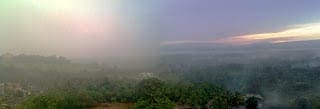Haiku is a poetic art form which has become popular in the 20th and 21st centuries. Its appeal lies in the crisp but lovely rendition of a moment, a meaningful potrayal in a chaotic and rushed world. Closely tied to the Japanese aesthetic of ‘Yugen’ and the spirituality of buddhism,a haiku looks deceptively simple, yet may take years to master. It is basically a 3 line depiction of telling moments, in a 17 syllable form. This is generally broken up into three lines of 5-7-5 syllables correspondingly.
Here is an example from one of the great masters of Haiku, Basho (1644-94)
An old pond..
a frog leaps in
the waters sound
And another one by Basho too:
Temple bells die out.
The fragrant blossoms remain.
A Perfect evening!
Traditional Haiku-s have a lot of inherent intricacies, like using something called ‘kigo’ that is a word which contains an image of the current season. A lot of importance was given to seasonal imagery in the Japanese format, but in the other languages,especially English the use of non-natural images common to modern life is allowed.
To end it up, here’s a haiku I wrote in chemistry class:
sitting in lectures,
heights of insipidity
catching up lost sleep.
P.S. : I did not imply anything with the haiku, it was my first try.


Good Try! Where did you find this? And now i know how engineering lectures are spent!! or shall i put it this way
An engineering class
An old art form
on to the manipal blog 🙂
My brother used to do these things long ago, but I got interested recently.And nice! except that it is not exactly a haiku-it should follow the 5-7-5 syllables..
and I said I did not imply anything 😛
Well, keep trying I shall 🙂